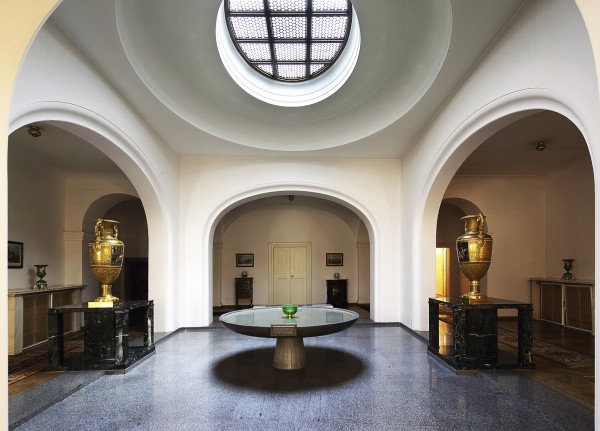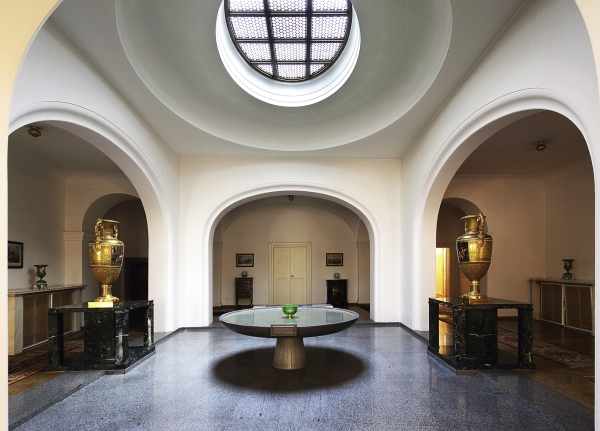Prague Castle & Plečnik
Architektur im Ringturm, Vienna, 27. 06. – 23. 09. 2016

Prague Castle is one of the world’s largest preserved castle complexes, and is a symbol of the Czech Republic’s sense of national pride. To accompany this year’s artistic covering of the Ringturm designed by Czech artist Ivan Exner, the Architektur im Ringturm series will focus on the unique architectural features of Prague Castle. The exhibition concentrates on the work of Slovenian architect Josef Plečnik.
After the Czech Republic gained independence in 1918, a seat of office was required for the country’s first president, Tomáš Garrigue Masaryk. Initially, Prague Castle was ruled out – it had been the Habsburgs’ administrative seat for centuries and was considered unsuitable. However, President Masaryk chose the site as the location for his office, and also proposed making the entire complex accessible to the general public by means of targeted construction measures. To avoid sparking controversy among the country’s architects, Masaryk commissioned Josef Plečnik, previously a student of Otto Wagner, to carry out the work.
President Masaryk, a former university professor, member of the imperial parliament in Vienna and a leading intellectual in his home country, was convinced that art had a decisive part to play in establishing a democratic state. In Plečnik he had found someone with the wherewithal to provide architectural designs worthy of his political ideas – a view he shared with his daughter Alice Masaryk.
The president was especially taken by Plečnik’s proposal to construct an obelisk with an eternal flame in the Paradise Garden, in memory of Czechoslovakia’s fallen legionnaires. Plečnik was added to the list of non-Czech artists – starting with Matthias of Arras, Peter Parler and Nicolaus Pacassi – who played a decisive part in shaping Prague Castle’s modern-day appearance. Completed between 1920 and 1934, Plečnik’s designs at the castle are considered a unique achievement in international architectural history, distinguished by a specific and authentic architectural language.
Courtyards, gardens and interiors
As the master of works, Plečnik had to treat the existing building stock with the utmost care. He designed courtyards with fountains and monuments, gardens with viewing pavilions and aviaries, as well as numerous high-quality interior pieces such as stand-alone furnishings, chairs, decorative items and everyday objects for Masaryk, some of which are still in use today.
It is worth emphasising the sense of responsibility that permeated the work. As part of the transition to a democratic state, the aim was to return Prague Castle to its original form, a form that had its roots in the pre-Habsburg era. The following anecdote illustrates the point: Plečnik was paid a reasonable sum for his design for the library, but returned the money, keeping only a small portion for travel expenses. His reasoning was that his creations represented architecture that would stand the test of time, and was more than simply paid work.
Plečnik quickly developed an intimate affection for the President’s daughter, Alice Masaryk. However, in view of the commission and its significance for the country’s future, the couple curbed their feelings for one another, so that emotions would not interfere with Plečnik’s work.
Use of locally sourced materials and traditional techniques in the designs was very important to Plečnik. He decided not to add any entirely new components, working instead only with available construction elements, which he began to enhance, giving them a monumental appearance, as well as using them in completely new contexts. After the medieval passageways – which had disappeared in the course of Pacassi’s baroque-era renovations – had been reopened, the adjoining royal gardens, cathedral and courtyards provided ample inspiration. National iconography, which the deeply religious Plečnik augmented with Christian imagery, also played a part in the artist’s thinking. Examples include the stars on the statue of John of Nepomuk, the patron saint of the Czech Republic, and the stylised representation of the waves on the Vltava river, found in the alcove on the Bull Staircase.
Plečnik created a new pedestal as well as an enclosure in the form of a “floating halo” for the fountain of St George, which dates back to the Middle Ages. The architect’s work also commemorates the prophetess Libuše and other Czech legends – the female head with an aureole of stars symbolises Libuše’s prophecy of the foundation of the city of Prague. Taking his cue from ancient art, Plečnik often blended national symbols with examples of Greek art, as seen in the canopy on the Bull Staircase, and the fact that the antique bulls could easily be mistaken for the oxen of the first Přemyslid ruler was of no importance to him – the architect may even have flirted with the idea of such a mix-up. This syncretism was modelled on the sculpture of a bull that adorns a gravestone in Kerameikos, a suburb of Athens, and supposedly also on a portal at a farm near Zvolen, which Plečnik had seen on a school trip to Slovakia. Stylised lime tree leaves were also deeply symbolic for Plečnik and can be seen all around the castle complex. Alice Masaryk believed that they reflect a sense of belonging to the Slavic peoples.
Symbolism is a major aspect of Plečnik’s renovation of the castle. However, he never lost sight of his training with Otto Wagner, with its strong emphasis on the proper processing of materials as a means of bringing out the properties of stone, wood and other building materials to the greatest possible effect. Spurning modern functional forms, Plečnik proved adroit at implementing Semper’s metamorphosis of the formal repertoire of ancient art. In effect, his work centred on perennial issues in architecture, which he brought up to date using an “antiquated” approach, unlike his contemporaries. This is the essence of his designs, and also the reason why Plečnik cannot be classified as a functionalist and even less so as an eclectic artist. He wanted to create art that transcended time and would never lose its aesthetic appeal.
Initially, Jan Kotěra was commissioned to build the presidential apartment on the second floor, but Alice Masaryk was unhappy with his modish design. So Plečnik, a friend of Kotěra, assumed responsibility for the work. Although the original plans were at an advanced stage, this did not result in a rift between the two architects. The existing layout seemed problematic, as the long suite of rooms did not have a focal point, or a proper point of access. But Plečnik solved this problem with the impluvium and the granite basin at its centre. The architect even told of crawling around the basin with Masaryk, both on their hands and knees, so that he could draw the president’s attention to the perfect stonemasonry from a different perspective. Luckily, there was no one else around to see them.
Plečnik built the apartments to the east of the impluvium, mainly using the existing furnishings, with the exception of the library and the president’s study. The latter was sparsely furnished, with a desk, a lectern and a wall fountain in veined green Silesian marble. The room featured book shelves on all sides, and in the view of the president’s daughter it would serve as the intellectual heart of the castle, so that the story of the finest hour in Czechoslovakian democracy could be passed on to future generations.
The design of the Ladies’ Salon was far more ornamental, featuring Moravian and Slovakian embroidery and rustic pottery. In spite of the extensive use of folk art, the overall impression was extremely lavish, and on a par with what might be termed high art. The design was enthusiastically received by Alice Masaryk, who is said to have called it “pastoral without the pastorality”. In addition to the couch, the room also included a recliner that reflected Plečnik’s vision of the appearance of antique metal armchairs mentioned by Semper. Plečnik transformed the neighbouring room into a lounge and music room. To provide the requisite access to the private quarters and lounges, Plečnik built a round staircase with a lift. The unplastered brick interior walls with their prominent pointing also reflect the medieval construction methods previously found at the site.
By removing parts of the castle fortifications originating from the 19th century, Plečnik opened up eye-catching views of the city. The middle bastion was converted into a viewing terrace and the paving adorned with mosaics. With its Mediterranean-style pergola, obelisk and granite table, the Moravian Bastion at the end of the Rampart Garden was intended as a place of peace and tranquillity for the president. The profile of the table top gives the impression of an imaginary tablecloth, while the brick and stone paving is reminiscent of a woven carpet. In an audacious move, Plečnik pushed the properties of granite to the limit with his slim, ten-metre-high obelisk. With its Doric capital, the monolith is a mix of classical obelisk and Doric column. The pavilions and belvederes are another essential element of the gardens – they serve as a frame for various panoramic vistas of the Czech capital, and offer attractive new perspectives on the city.
Plečnik’s strategy for the renovation involved drawing attention to of the existing architecture, as well as creating a pathway through the gardens that opens up fascinating views of the castle from various angles. To this end he used load-bearing arcades to extend the Rampart Garden, connecting it with the Powder Bridge and Royal Garden via a connecting bridge. Unfortunately this idea was never implemented – following Plečnik’s departure, the plan to join the castle and Queen Anna’s summer residence was shelved.
Almost a century later, with functionalism having given way to other styles, we live in age of artistic pluralism that is difficult to pin down. Against this backdrop, Plečnik’s work at Prague Castle takes on a whole new dimension. Nobody takes exception to the columns he designed – on the contrary, they illustrate how much vitality such elements and ancient art as a whole still exude. Plečnik brings home the idea that proportion, rhythm and context have been the most important components of architecture throughout the ages. He also provides a lesson in how to make use of classical materials. Although modern-day methods are different, Plečnik’s architecture comprises countless interesting facets that remain contemporary to this day.




